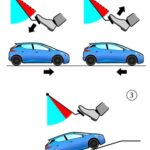Slide 1. Introduction.
The class develops what an electric vehicle inverter is and what it is used for.
Slide 2. Electric vehicle inverter: What it is and what it is used for.
- Why is the inverter essential in an electric car?.
The inverter is a key component in the operation of the vehicle's electrical system. It converts, regulates, and manages the energy that allows the car to move, brake efficiently, and make the most of each charge.
Without the inverter, the electric motor could not function, regenerative braking would be impossible, and the vehicle's range would be seriously compromised. Although it is not a visible component or one that is highlighted by manufacturers, its role is decisive in the driving experience of an electric car.
- What is the function of the inverter in an electric car?.
The inverter has one main mission: to convert the direct current (DC) stored in the batteries into alternating current (AC), which is what the electric motor needs to operate. It also regulates the frequency and voltage of that current, allowing the vehicle to accelerate progressively and brake smoothly.
This conversion allows for precise control of the motor torque, offering a more refined response to the driver. It is important for the car to respond correctly to the commands of the accelerator or braking system.
- How does the inverter work within the vehicle's electrical system?.
In an electric vehicle, there is an important difference between alternating current and direct current. The inverter in an electric vehicle is the device that converts the direct current from the battery into the alternating current used by the electric motor. The former has a defined and constant polarity, while the latter can alternate its polarity over time.
This variation is called frequency and is measured in hertz (Hz). Frequency is the speed at which the voltage changes from positive to negative, that is the number of times the sine wave is completed. A frequency of 2 hertz indicates that the sine wave has been repeated twice in one second.
If the motor were powered by fixed-frequency alternating current, then its speed would be fixed. However, the inverter is responsible for supplying the motor with variable-frequency alternating current that adjusts to the accelerator pedal, in order to modulate the speed. A higher frequency results in a higher speed of the electric motor.
The inverter in an electric car controls the torque and speed of the vehicle's electric motor and therefore determines driving performance in conjunction with the information sent by the accelerator pedal itself.
In this case, it does not matter what type of electric motor the vehicle has, whether it is asynchronous or synchronous, brushless or any other type. Ultimately, the inverter receives its electrical power supply from the battery in direct current and delivers it to the electric motor in a three-phase system.
- Why is the waveform in alternating current important?.
Direct current electricity produces a very sharp square wave. In contrast, alternating current electricity generates a smoother sinusoidal waveform. This is important because electric car motors need time to increase and decrease power. That is why alternating current is more suitable for their operation.
The inverter uses power transistors or diodes as switches that “chop” the direct current electricity to create an alternating current output. Alternating current has positive and negative voltages in its cycle, and the transistors open and close connections that alternately allow the voltage to pass through unchanged or make it negative.
By turning the diodes on and off very quickly, the output voltages can be “built” by mixing short bursts of positive and negative volts in varying amounts to achieve an average voltage that follows the sine waveform. This technique, known as “pulse width modulation,” can be supplemented by filtering through electronic components that smooth the signal, producing a pure sinusoidal alternating current output.
The alternating current motors used in electric vehicles are three-phase. This means that they operate with three separate alternating current currents that compensate each other over time. This means that phase 2 reaches its positive peak slightly after phase 1 and phase 3 reaches its peak slightly after phase 2. This creates a set of rotating magnetic fields in the motor, which is what causes the motor rotor to rotate. Therefore, the inverter in our vehicles does not produce one alternating current output but three.
The alternating current generated by the inverter cannot be just any type of signal. It must have a sinusoidal waveform, as this allows for efficient, safe, and stable transmission. If the waveform is not adequate, the electric motor may behave erratically, generating vibrations or even malfunctions.
A clean, well-controlled sine wave prevents interference and allows the motor to work optimally. That is why the highest quality inverters are those capable of generating a signal as close as possible to the ideal wave.
- How does the inverter intervene in regenerative braking?.
The inverter allows the flow of energy to be reversed. When the car decelerates—whether by releasing the accelerator, going downhill, or braking—the motor acts as a generator. At that moment, the inverter channels the energy generated back to the battery.
This process, known as regenerative braking, not only partially recharges the battery, but also reduces wear and tear on the mechanical braking system. Instead of being dissipated as heat, the energy is reused, extending the vehicle's range and improving its energy efficiency.
- What are the differences between a 400 volts inverter and an 800 volts inverter?.
The main difference between these two types of inverters lies in the voltage at which they operate. 800 volts inverters allow for faster charging, less energy loss, and a reduction in the total weight of the electrical system. However, they require more expensive components and a compatible charging infrastructure, which is not yet widespread.
400 volts inverters, on the other hand, remain the most widespread standard in most current electric cars. They offer a good balance between cost, performance, and compatibility with the public charging network. As technology advances, 800 volts systems will gain ground, especially in high-end models and vehicles with greater range and performance requirements.
In practice, an 800 volts system allows 80% recharging in just 20 minutes, which is undoubtedly a big plus for vehicles that use it.
Slide 3. Thank you for your time.
The class has developed what an electric vehicle inverter is and what it is used for, see you soon.
Download the audio




















